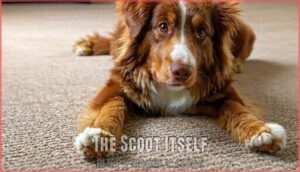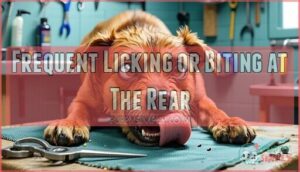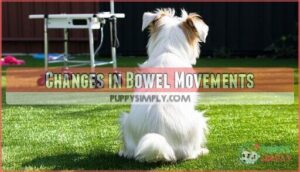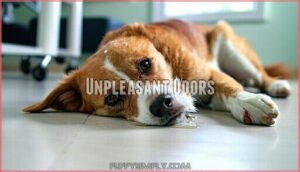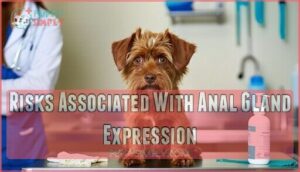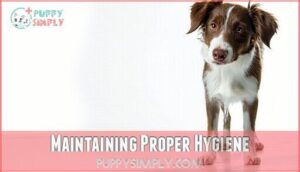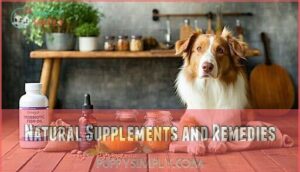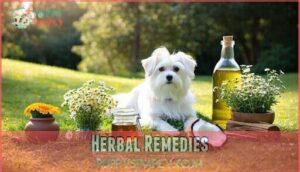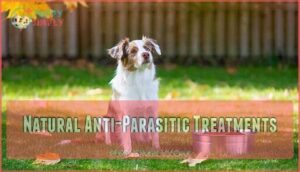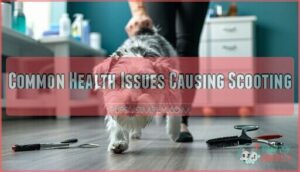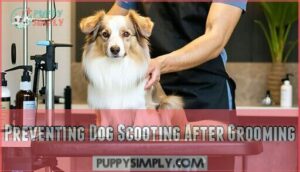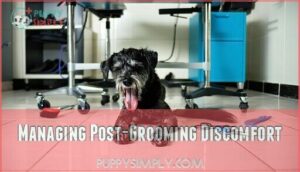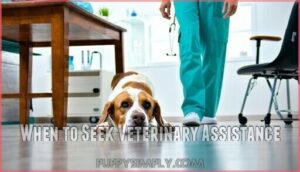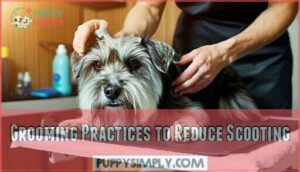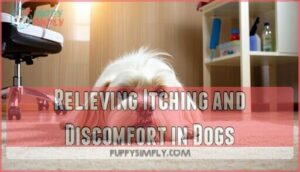This site is supported by our readers. We may earn a commission, at no cost to you, if you purchase through links.
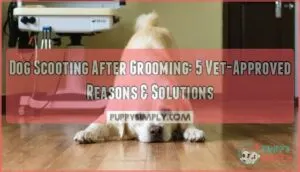
Dog scooting after grooming typically happens due to irritated anal glands, razor burn, or nicks from grooming tools.
Your groomer might’ve accidentally expressed your pup’s anal glands during cleaning, causing temporary discomfort. Sometimes it’s just sensitive skin reacting to new shampoos or tight trimming around the rear area.
While occasional scooting isn’t alarming, persistent dragging could signal infection or impacted glands. Understanding the specific triggers and simple solutions can help your furry friend find relief quickly and address potential issues like impacted glands.
Table Of Contents
- Key Takeaways
- Causes of Dog Scooting After Grooming
- Identifying Scooting Behavior in Dogs
- Risks Associated With Anal Gland Expression
- Home Remedies for Dog Scooting
- Common Health Issues Causing Scooting
- Preventing Dog Scooting After Grooming
- Managing Post-Grooming Discomfort
- When to Seek Veterinary Assistance
- Grooming Practices to Reduce Scooting
- Relieving Itching and Discomfort in Dogs
- Frequently Asked Questions (FAQs)
- Why is my dog scooting so much after grooming?
- How to stop a dog from scooting after grooming?
- Why does my dog keep sitting on his bum after grooming?
- When should I worry about dog scooting?
- How long does scooting typically last after grooming?
- Can certain dog breeds scoot more after grooming?
- Should I bathe my dog before grooming sessions?
- What grooming tools cause the most scooting issues?
- Is scooting normal for first-time grooming visits?
- Conclusion
Key Takeaways
- You’ll notice scooting behavior within 24-48 hours after grooming, typically caused by anal gland irritation, clipper burn, or skin sensitivity from grooming products and procedures.
- You can provide immediate relief using cool compresses, oatmeal baths, coconut oil, or aloe vera gel to soothe irritated skin and reduce post-grooming discomfort.
- You should contact your vet if scooting persists beyond 48 hours, or if you notice swelling, discharge, bleeding, strong odors, or signs your dog’s in significant pain.
- You can prevent future scooting by choosing experienced groomers who use gentle techniques, proper anal gland expression methods, and hypoallergenic products suitable for sensitive skin.
Causes of Dog Scooting After Grooming
You’ve probably noticed your dog dragging their bottom across the floor right after a grooming session, and there’s usually a specific reason behind this behavior.
Post-grooming scooting typically stems from anal gland issues, skin irritation, or discomfort caused by the grooming process itself, which can be considered a complete concept in understanding the behavior.
Blocked Anal Sacs
Your dog’s anal glands might be blocked after grooming, creating uncomfortable pressure that triggers post grooming scooting.
These glandular secretions normally empty during bowel movements, but impaction causes buildup.
Groomer related issues often involve expression techniques that don’t fully clear the anal glands.
Dietary impact matters too—low-fiber foods worsen anal gland issues, making infection prevention essential through proper care.
Infected Anal Sacs
When grooming disrupts infected anal sacs, your dog’s scooting intensifies dramatically.
These infection symptoms include swelling, pus discharge, and that unmistakable fishy smell that makes you wrinkle your nose.
Antibiotic options from your vet typically clear mild cases, while severe abscess treatment may require surgical removal.
Without proper care, long-term effects include chronic anal sac disease, making future grooming sessions miserable for everyone involved.
Perianal Irritation
Your dog’s sensitive perianal skin can become irritated during grooming from clipper burn, harsh products, or allergic reactions.
These causes create redness, swelling, and itching that triggers scooting behavior. Symptoms include excessive licking and visible inflammation around the rear area.
Prevention involves using gentle, hypoallergenic grooming products and proper clipper techniques. Relief comes through cool compresses and soothing treatments to reduce complications, providing relief.
Expression of Anal Glands
When your groomer performs anal gland expression, residue and irritation often trigger scooting behavior afterward.
This routine procedure can leave your dog uncomfortable.
Common expression techniques that cause scooting include:
- External manual expression – Creates temporary discomfort and residual secretions
- Incomplete glandular secretions removal – Leaves irritating fluids on skin
- Improper groomer training – Results in excessive pressure or poor technique
- Veterinarians role confusion – Some groomers lack proper medical training
- Post-expression sensitivity – Normal reaction to anal glands manipulation during dog grooming
The techniques listed are factors that contribute to the discomfort experienced by dogs after anal gland expression.
Pain or Discomfort
Rough handling during grooming sessions can leave your furry friend feeling tender and sore.
Clipper burn, nicks, or excessive pressure create discomfort that triggers dog scooting after grooming as they seek relief from their sore bum.
| Pain Source | Symptoms | Prevention |
|---|---|---|
| Clipper burn | Red, irritated skin | Use proper blade temperature |
| Nicks/cuts | Visible wounds, bleeding | Gentle techniques, sharp tools |
| Rough handling | Anxiety, flinching | Calm approach, breaks |
| Pressure sores | Tender spots, swelling | Light touch, proper restraint |
Post-procedure care and anxiety reduction help manage grooming trauma through pain management strategies.
Identifying Scooting Behavior in Dogs
You’ll recognize scooting when your dog drags their bottom across the floor, carpet, or grass in a sitting position.
This behavior often comes with excessive licking or biting at their rear end, changes in how they move their bowels, and sometimes a fishy or unpleasant smell around their back end, which can be a sign of a health issue related to their rear end.
The Scoot Itself
You’ll recognize the classic "butt drag" immediately when your dog starts their carpet routine.
Your pup sits down and uses their front legs to pull themselves forward, leaving their rear end in contact with the surface.
Here’s what makes dog scooting after grooming so distinctive:
- Surface Preference – Dogs typically choose rough textures like carpets, rugs, or grass over smooth floors
- Scooting Mechanics – The dragging motion creates friction to relieve anal gland issues or irritation
- Frequency Analysis – Post-grooming scooting often happens in clusters rather than isolated incidents
- Intensity Variation – Some dogs scoot vigorously while others make gentle, repeated attempts
- Behavioral Significance – The behavior usually stops once the underlying discomfort gets addressed
Frequent Licking or Biting at The Rear
Post-grooming stress can trigger compulsive licking behaviors that signal underlying anxiety.
You’ll notice your dog obsessively targeting their rear end, creating a cycle of irritation.
This excessive licking often indicates perianal irritation from dog grooming procedures.
| Behavioral Analysis Signs | Owner Intervention Steps |
|---|---|
| Constant rear-end attention | Monitor licking frequency |
| Raw or red skin patches | Apply gentle cold compress |
| Whimpering during licking | Use protective cone collar |
| Restless pacing behavior | Schedule vet consultation |
Watch for wound prevention opportunities through immediate intervention when dog scooting after grooming escalates to destructive itching patterns.
Changes in Bowel Movements
Changes in your dog’s bowel movements after dog grooming can signal digestive upset.
Watch for diarrhea or unusually soft stools, which may indicate stress from the grooming experience.
Poor stool consistency affects natural anal gland expression during bowel movements.
Increasing fiber intake, maintaining proper hydration levels, and adding probiotics benefit digestive health.
Consider digestive enzymes if dog scooting persists alongside irregular bowel patterns.
Unpleasant Odors
Your nose will tell you something’s wrong before your eyes do.
That fishy, musty smell signals anal gland issues – the top cause of dog scooting after grooming.
When these scent-marking glands become impacted or infected, they release an unmistakable odor that’ll clear a room.
Poor hygiene amplifies these unpleasant odors, making odor elimination essential for comfort.
Sometimes, this is due to anal gland impaction, requiring veterinary intervention.
Risks Associated With Anal Gland Expression
While anal gland expression can provide relief for your dog’s discomfort, it’s not without risks when performed incorrectly.
Improper technique can lead to serious complications including infections, abscesses, and unnecessary pain that may worsen your pet’s scooting behavior, which can be a significant issue for your pet.
Complications From Improper Technique
When groomers use excessive force or poor technique during anal gland expression, serious complications can develop that go far beyond simple irritation.
- Rectal tears and anal trauma from rough handling require immediate veterinary intervention
- Chronic scooting develops when damaged glands lose their natural emptying ability
- Infection risks skyrocket due to bacterial contamination from improper expression methods
- Irritation amplification occurs when clipper burn combines with traumatic gland manipulation
To avoid these issues, it’s essential to understand proper anal gland function.
Infection or Abscess Formation
Infection or abscess formation represents serious complications that can occur when anal glands aren’t properly expressed.
These bacterial infections cause severe swelling, pain, and potential rupture of the anal sacs.
| Complication Type | Symptoms | Treatment Required |
|---|---|---|
| Mild Infection | Swelling, discharge, fishy odor | Antibiotic use, warm compresses |
| Moderate Infection | Pain, bloody discharge, fever | Prescription antibiotics, pain management |
| Severe Abscess | Rupture, pus drainage, extreme pain | Surgical options, intensive care |
| Chronic Infections | Recurring episodes, scarring | Long-term abscess treatment plan |
| Emergency Cases | System-wide illness, lethargy | Immediate veterinary intervention |
Dog grooming infections from improper anal gland expression can escalate quickly.
Infection prevention starts with proper technique and sterile conditions.
When dog scooting persists after grooming, bacterial invasion of damaged tissue creates painful abscesses requiring immediate attention.
Discomfort or Pain
Even when anal gland expression goes smoothly, your dog may experience discomfort or pain afterward.
The pressure applied during the procedure can cause muscle tension and handling sensitivity, leading to grooming trauma.
Dogs with anxiety may show behavioral changes like restlessness or reluctance to sit.
This post-grooming discomfort often triggers dog scooting as they seek relief from clipper burn, irritation, and lingering pain through anxiety relief behaviors.
Home Remedies for Dog Scooting
When your dog starts the dreaded "butt scoot" dance across your carpet after grooming, you don’t need to panic or rush to the vet immediately.
Several gentle home remedies can provide relief and address the underlying causes of this uncomfortable behavior.
Maintaining Proper Hygiene
Keeping your dog clean after grooming prevents dog scooting and reduces irritation.
Regular bathing frequency and coat brushing remove debris that causes discomfort.
These dog hygiene tips maintain healthy skin:
- Bathing Frequency: Weekly baths with gentle shampoo
- Coat Brushing: Daily brushing prevents matting and buildup
- Paw Care: Clean between toes after walks
- Ear Cleaning: Weekly cleaning prevents infections
For bathing, consider using a gentle dog shampoo.
Proper dog grooming hygiene stops problems before they start.
Dietary Adjustments
What you feed your dog directly impacts dog scooting behavior after grooming.
Boosting fiber intake helps form firmer stools that naturally express anal glands during bowel movements. Add pumpkin or sweet potato to your dog’s diet for natural digestive support.
Probiotics benefits include better gut health and reduced inflammation. Consider allergy elimination diets if food sensitivities trigger skin irritation.
Hydration importance can’t be overstated – proper water intake keeps everything moving smoothly. Digestive enzymes aid nutrient absorption and digestive health. Probiotics benefits are also crucial for overall well-being.
Natural Supplements and Remedies
Beyond dietary tweaks, natural supplements can tackle dog scooting from multiple angles.
Omega-3 supplements reduce inflammation while probiotic benefits support gut health. Adding dietary fiber through psyllium or pumpkin helps firm stools for better anal gland expression.
Apple cider vinegar creates an unfriendly environment for parasites. These dog scooting remedies work alongside home remedies to address grooming-related discomfort naturally.
A warm compress can soothe irritated areas around the anus.
Herbal Remedies
Herbal remedies offer gentle, natural topical relief for dog scooting after grooming.
Calendula benefits include accelerating tissue repair and preventing infections when applied as salves.
Chamomile uses encompass reducing inflammation through tea compresses on irritated areas.
Coconut oil provides antibacterial properties, while diluted apple cider vinegar offers antiseptic benefits.
These home remedies complement traditional treatments effectively, providing gentle and natural relief.
Natural Anti-Parasitic Treatments
Parasites can trigger scooting after grooming sessions.
Herbal dewormers like pumpkin seeds contain cucurbitacin, which paralyzes intestinal parasites naturally.
Ground pumpkin seeds (1 teaspoon per 10 pounds) offer safe alternatives to chemical treatments.
Dietary prevention through fiber-rich foods helps scrape parasites away.
Probiotic support strengthens gut health, while this holistic approach addresses root causes effectively without harsh medications, using a method that is naturally effective.
Common Health Issues Causing Scooting
While grooming resolves most hygiene issues, it can sometimes reveal or trigger underlying health problems that cause scooting behavior.
Understanding these common conditions helps you determine whether your dog’s post-grooming scooting requires immediate veterinary attention or simple home care.
Anal Gland Problems
Anal gland problems top the list when your dog starts scooting after grooming.
Gland impaction happens when these small sacs can’t empty naturally, creating uncomfortable pressure.
Infection risks increase if bacteria enter blocked glands, potentially leading to painful abscesses requiring immediate treatment.
Your groomer’s expression frequency matters—too often irritates, too rarely causes buildup.
Dietary impact plays a role too, as fiber helps natural emptying during bowel movements, and proper care can prevent gland impaction.
Intestinal Parasites
Your dog’s grooming session might’ve stirred up more than just loose fur—parasites like tapeworms and roundworms can cause intense anal itching that triggers dog scooting.
These unwelcome guests irritate your pup’s digestive system, making them drag their rear across your carpet.
Regular deworming schedules and fecal exams help catch these critters early, while antiparasitic treatments eliminate them completely.
Allergies
Food allergies and environmental allergens can trigger intense itching that makes your dog scoot after grooming.
Seasonal allergies often worsen skin sensitivity, causing post-grooming irritation.
Your groomer’s products might contain allergens your pup can’t tolerate.
Signs your dog’s scooting stems from allergies include:
- Red, inflamed skin around the rear end
- Excessive scratching or licking after grooming sessions
- Recurring scooting episodes during specific seasons
Allergy testing helps identify triggers, while allergy medications provide relief for persistent dog skin allergies.
Tumors
While rare, tumors can trigger dog scooting after grooming sessions.
Perianal tumors and anal sac disease create discomfort that makes your pup drag their bottom across surfaces.
Benign tumors are more common than malignant ones, but both require veterinary intervention for proper diagnosis and treatment options.
| Tumor Location | Common Types |
|---|---|
| Perianal area | Hepatoid gland adenomas |
| Anal sacs | Adenocarcinomas |
| Surrounding tissue | Mixed benign/malignant |
Preventing Dog Scooting After Grooming
You can prevent your dog from scooting after grooming by taking a few simple steps before and after their spa day.
The key is addressing potential triggers like anal gland issues, skin sensitivities, and grooming-related irritation before they become uncomfortable problems.
This approach helps in making the dog more comfortable and reducing the likelihood of scooting.
Regular Vet Check-ups
Scheduling routine veterinary consultations helps catch dog health concerns before they escalate into scooting episodes.
Your vet can spot early warning signs during regular examinations that you might miss at home.
- Early detection through parasite screening prevents intestinal worms that trigger scooting
- Preventative care includes vaccination updates and health monitoring for overall wellness
- Veterinarian consultation addresses anal gland issues before they require emergency treatment
Balanced Diet
A healthy balanced diet serves as your dog’s first line of defense against scooting after grooming sessions.
Proper fiber intake promotes regular bowel movements, naturally expressing anal glands and reducing impaction risks.
Quality probiotics benefits include supporting digestive health and minimizing inflammation.
Consider supplement choices like omega-3 fatty acids for skin health, while maintaining hydration importance through fresh water access daily.
Proper Grooming Techniques
Proper dog grooming techniques prevent scooting through gentle handling and careful tool selection.
Use sharp, well-maintained clippers to avoid clipper burn, which causes post-grooming irritation. Keep sanitary trims minimal around sensitive areas.
Maintain appropriate bathing frequency—over-washing strips natural oils. Use proper drying methods to prevent moisture buildup.
Quality dog grooming techniques prioritize dog grooming safety over speed, ensuring a safe and healthy experience through proper dog grooming.
Regular Deworming
Intestinal parasites like tapeworms and roundworms can trigger dog scooting after grooming sessions.
Establishing a consistent deworming schedule prevents these unwelcome guests from causing rear-end irritation.
- Fecal Exams: Schedule annual screenings to detect parasites early
- Broad-Spectrum Dewormers: Use veterinarian-recommended products for thorough protection
- Preventative Deworming: Follow your vet’s timeline for routine treatments
- Parasite Resistance: Rotate deworming products to maintain effectiveness
Allergy Management
Allergic reactions can turn grooming day into scooting season faster than you’d expect.
Identify allergens through allergy testing or by switching to hypoallergenic products and monitoring your dog’s response.
Common dog grooming allergies include fragrances, dyes, and harsh chemicals in shampoos.
Make dietary changes if food allergies contribute to skin sensitivity, and focus on symptom relief through gentle, fragrance-free grooming products to manage pet grooming allergies effectively.
Managing Post-Grooming Discomfort
When your dog starts scooting after a grooming session, you’re likely dealing with temporary irritation that needs quick attention.
The good news is that most post-grooming discomfort responds well to simple home treatments and usually resolves within a few days.
Treating Razor Burns
When clipper burn strikes after grooming, swift action prevents your pup’s discomfort from escalating into a bigger issue.
Apply cooling treatments immediately to soothe inflamed skin and promote faster healing.
- Aloe application: Use pure aloe vera gel without additives for immediate cooling relief
- Herbal soaks: Create chamomile tea baths to reduce inflammation naturally
- ACV treatment: Dilute apple cider vinegar (1:3 ratio) for gentle antiseptic care
- Veterinary care: Seek professional help if clipper burn healing stalls or worsens
Managing Cuts or Wounds
Sometimes accidents happen during grooming sessions, leaving your furry friend with small cuts or wounds.
First, examine the area for debris and gently clean with warm water. Apply triple antibiotic ointment to prevent infection and promote the healing process.
Monitor for signs of infection like swelling or discharge. For deeper wounds requiring veterinary attention, don’t delay seeking professional care for proper infection treatment.
Soothing Irritated Skin
Beyond treating cuts, you’ll want to address broader skin irritation that commonly follows grooming sessions.
Your dog’s sensitive skin needs gentle care to heal properly and prevent further discomfort.
Here are effective methods for soothing irritated skin:
- Cool Compresses – Apply clean, damp cloths to reduce inflammation and provide immediate relief
- Oatmeal Baths – Use colloidal oatmeal to calm dog grooming clipper burn and perianal irritation naturally
- Coconut Oil application – Massage small amounts into affected areas for moisturizing relief
- Aloe Application – Use pure aloe vera gel for cooling comfort on irritated skin
- Herbal Remedies – Try calendula or chamomile treatments for gentle, natural healing
These solutions target dog grooming skin disorders while addressing dog grooming sore bum issues effectively.
For persistent issues, consider hypoallergenic shampoos to avoid further irritation.
Itch Relief
When your dog’s rear end feels like it’s on fire, cool compresses can work wonders for itching relief and perianal irritation.
Here’s your grooming aftermath survival kit:
| Quick Relief | Method |
|---|---|
| Cool compresses | Apply 10-15 minutes |
| Yogurt benefits | Plain yogurt topically |
| Herbal soaks | Chamomile tea rinse |
Remember, hydration importance can’t be overstated—well-hydrated skin heals faster.
For stubborn dog scooting causes, CBD application might help, though consult your vet first for proper dog scooting relief strategies.
When to Seek Veterinary Assistance
While most post-grooming scooting resolves within 24-48 hours, you’ll need professional help if your dog continues dragging their rear end beyond this timeframe.
Contact your vet immediately if you notice swelling, discharge, bleeding, or if your pup seems genuinely distressed rather than just mildly uncomfortable, which may indicate a need for urgent professional help.
Persistent Scooting
When scooting continues beyond 24-48 hours after grooming, underlying causes like perianal irritation or clipper burn may need professional evaluation.
Persistent behavioral changes signal deeper issues requiring veterinary attention.
- Underlying causes include impacted anal glands, infections, or grooming-related trauma that won’t resolve naturally
- Dietary impact assessment helps identify food sensitivities contributing to ongoing discomfort and inflammation
- Veterinary options provide long-term relief through proper diagnosis, medication, and specialized treatment plans
Signs of Infection
When dealing with post-grooming dog scooting symptoms, infection signs require immediate veterinary attention.
Watch for telltale indicators that signal your pet’s condition has escalated beyond simple irritation.
| Visible Signs | Behavioral Changes |
|---|---|
| Pus discharge from anal area | Fever and lethargy |
| Swelling redness around anus | Appetite loss or refusal to eat |
| Foul odor intensifying | Whimpering during bowel movements |
| Hot, tender skin to touch | Reluctance to sit normally |
These infection markers mean bacteria has taken hold, turning minor grooming irritation into a serious health concern requiring professional treatment.
Lethargy and appetite loss are concerning, as behavior changes matter when evaluating a dog’s health.
Severe Discomfort or Pain
When your dog shows extreme pain signs like whimpering, trembling, or refusing to sit, immediate veterinary attention is needed.
Some discomfort after grooming is normal, but severe pain indicates potential nerve damage or serious irritation requiring professional pain management and possibly surgical intervention.
- Constant whimpering or crying when touching the rear area suggests significant nerve damage
- Trembling, panting, or restlessness indicates your dog needs immediate pain management intervention
- Refusal to sit, lie down, or walk normally points to severe discomfort requiring veterinary assessment
- Aggressive behavior when approached from behind signals chronic pain that may need palliative care
- Visible swelling, bleeding, or open wounds demand surgical options evaluation by your veterinarian
Grooming Practices to Reduce Scooting
You can prevent post-grooming scooting by choosing experienced groomers who handle dogs gently and know proper anal gland expression techniques.
Make sure your groomer uses light pressure and avoids aggressive handling that could irritate sensitive areas around your dog’s rear end, ensuring a gentle and safe experience with proper care.
Gentle Handling
Your groomer’s hands shouldn’t feel like wrestling a crocodile. Gentle handling prevents dog scooting treatment needs by reducing stress and irritation during grooming sessions.
| Gentle Technique | Why It Helps |
|---|---|
| Calming Techniques | Reduces anxiety that leads to scooting |
| Positive Reinforcement | Makes dogs cooperate willingly |
| Comfortable Positioning | Prevents muscle strain and discomfort |
| Gradual Introduction | Helps nervous dogs adjust slowly |
Rough handling around anal glands creates irritation that triggers scooting behavior afterward.
Proper Anal Gland Expression
When groomers lack proper veterinarian training in expression techniques, they risk causing trauma through excessive pressure or improper positioning.
External expression involves gentle pinching around the anal opening, while internal expression requires inserting a lubricated finger at specific angles.
Home expression isn’t recommended—manual gland expression demands precision to avoid rupturing delicate tissues, making professional anal glands care essential for your dog’s gland health.
Dietary issues can also contribute to the problem, with allergies impacting gland health and leading to scooting.
Relieving Itching and Discomfort in Dogs
When your dog starts scooting after grooming, you’ll want to address their discomfort quickly to prevent further irritation.
These gentle, vet-approved remedies can help soothe your pup’s skin and reduce that urge to drag their bottom across your favorite rug, which are gentle and vet-approved.
Oatmeal Baths
Gentle oatmeal baths provide natural relief for grooming-related itching.
Grind plain oatmeal into powder, mix with lukewarm water for proper bath preparation.
The oatmeal benefits include soothing inflamed skin and reducing dog skin allergies.
Apply using gentle massage techniques, ensuring even coverage.
This grooming itching relief method addresses common dog scooting reasons through natural anti-inflammatory properties, offering safe comfort.
Coconut Oil and Aloe Vera Gel
Beyond soothing baths, coconut oil and aloe vera gel offer targeted relief from post-grooming irritation.
Application methods matter—massage small amounts of pure coconut oil into affected areas, or create cooling aloe vera sprays.
Benefits comparison shows aloe vera provides faster healing while coconut oil creates protective barriers.
However, potential risks include clogged pores from coconut oil overuse and digestive upset if ingested.
Always verify product purity and monitor for allergic reactions during home remedies.
Calming Massages
Sometimes gentle massage techniques work wonders for anxious pups dealing with post-grooming discomfort.
Use slow, circular motions around your dog’s shoulders and back to promote muscle relaxation and circulation benefits.
This calming approach reduces dog grooming stress and anxiety while supporting emotional wellbeing, and becomes a form of natural dog grooming trauma therapy with your soothing touch.
Your soothing touch becomes natural dog grooming trauma therapy, utilizing calming approach and gentle massage techniques to aid anxious pups.
Anti-Itch Creams and Sprays
Anti-itch creams and sprays offer targeted relief when your dog’s rear end feels like it’s on fire.
Look for hydrocortisone-based products specifically designed for dogs, as human formulations can be too strong. Always check cream ingredients and verify product safety before application.
Spray application works well for hard-to-reach areas, but consider veterinary options for persistent irritation.
These grooming products provide effective dog grooming itching relief when used correctly. Many owners find success with specialized creams for dogs, which can be a valuable resource.
Frequently Asked Questions (FAQs)
Why is my dog scooting so much after grooming?
Like a puzzle missing pieces, your pup’s rear end feels incomplete after grooming. Grooming can irritate anal glands, cause clipper burn, or trigger allergic reactions, making them scoot for relief.
How to stop a dog from scooting after grooming?
Apply cold compresses to reduce irritation, use coconut oil or aloe vera for soothing relief, and consider oatmeal baths. If scooting persists, consult your vet promptly.
Why does my dog keep sitting on his bum after grooming?
Dogs sit or scoot after grooming because 6-9% experience anal area irritation from procedures.
Your pup’s likely feeling uncomfortable from clipper burn, product reactions, or anal gland expression during grooming, causing him to seek relief.
When should I worry about dog scooting?
You should worry about dog scooting when it persists beyond 24-48 hours.
It involves excessive licking, produces blood or pus, causes visible swelling, or you notice a strong fishy odor around the anal area.
How long does scooting typically last after grooming?
Scooting usually resolves within 24-48 hours after grooming if it’s caused by minor irritation.
However, if you notice persistent scooting beyond three days, contact your vet since it might indicate anal gland issues or infection.
Can certain dog breeds scoot more after grooming?
Like snowflakes falling uniquely, certain breeds face greater post-grooming scooting challenges.
Short-legged breeds like Corgis and Bulldogs can’t reach their rear ends easily, while long-haired breeds accumulate more debris, making them scoot more frequently after professional grooming sessions.
Should I bathe my dog before grooming sessions?
Generally, you’ll want to bathe your dog before grooming sessions.
Clean fur makes trimming easier and prevents dirt from clogging clippers.
However, some groomers prefer working with slightly dirty coats for better grip during cutting.
What grooming tools cause the most scooting issues?
Electric clippers strike like lightning when they cause the most post-grooming scooting problems.
You’ll find that clippers create razor burn, nicks, and clipper burn around your dog’s sensitive anal area, leading to uncomfortable irritation and subsequent scooting behavior due to clipper burn.
Is scooting normal for first-time grooming visits?
Yes, it’s quite common for first-time grooming visits to trigger scooting behavior.
New dogs often experience stress, unfamiliar handling, and potential minor irritation from grooming procedures, making scooting a normal reaction.
Conclusion
Picture your freshly groomed pup dragging their rear across your clean carpet—you’re not alone in this messy mystery.
Dog scooting after grooming happens for several reasons, from irritated anal glands to sensitive skin reactions.
You’ll recognize the signs early and know when home remedies work versus when you need professional help.
Most scooting resolves within 24-48 hours with proper care, but persistent behavior requires veterinary attention to prevent complications.
- https://www.justanswer.com/dog-health/dkges-nicked-dog-s-grooming-keeps-scooting.html
- https://www.akc.org/expert-advice/vets-corner/anal-gland-disease-in-dogs/
- https://vcahospitals.com/know-your-pet/anal-sac-disease
- https://pubmed.ncbi.nlm.nih.gov/24797215/
- https://www.preventivevet.com/dogs/anal-glands-what-to-do-when-they-are-a-problem

